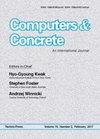Seismic behavior and failure modes of non-ductile three-story reinforced concrete structure: A numerical investigation
IF 3.3
4区 工程技术
Q2 COMPUTER SCIENCE, INTERDISCIPLINARY APPLICATIONS
引用次数: 5
Abstract
Reinforced concrete (RC) buildings in Taiwan have suffered failure from strong earthquakes, which was magnified by the non-ductile detailing frames. Inadequate reinforcement as a consequence of the design philosophy prior to the introduction of current standards resulted in severe damage in the column and beam-column joint (BCJ). This study establishes a finite element analysis (FEA) of the non-ductile detailing RC column, BCJ, and three-story building that was previously tested through a tri-axial shaking table test. The results were then validated to laboratory specimens having the exact same dimensions and properties. FEA simulation integrates the concrete damage plasticity model and the elastic-perfectly plastic model for steel. The load-displacement responses of the column and BCJ specimens obtained from FEA were in a reasonable agreement with the experimental curves. The resulting initial stiffness and maximum base shear were found to be a close approximation to the experimental results. Also, the findings of a dynamic analysis of the three-story building showed that the time-history data of acceleration and displacement correlated well with the shaking table test results. This indicates the FEA implementation can be effectively used to predict the RC frame performance and failure mode under seismic loads.非延性三层钢筋混凝土结构抗震性能及破坏模式的数值研究
台湾的钢筋混凝土(RC)建筑在强烈地震中遭受破坏,而非延性的细节框架则加剧了这种破坏。在引入现行标准之前的设计理念导致加固不足,导致柱和梁柱节点(BCJ)严重损坏。本研究建立了非延性混凝土细部柱、BCJ和三层建筑的有限元分析(FEA),之前通过三轴振动台试验进行了测试。然后将结果与具有完全相同尺寸和特性的实验室样品进行验证。有限元模拟将混凝土损伤塑性模型与钢的弹塑性模型相结合。有限元分析得到的柱和BCJ试件的荷载-位移响应与试验曲线吻合较好。所得到的初始刚度和最大基底剪力与实验结果非常接近。另外,对三层建筑的动力分析结果表明,加速度和位移时程数据与振动台试验结果吻合良好。这表明有限元分析可以有效地预测钢筋混凝土框架在地震荷载作用下的性能和破坏模式。
本文章由计算机程序翻译,如有差异,请以英文原文为准。
求助全文
约1分钟内获得全文
求助全文
来源期刊

Computers and Concrete
工程技术-材料科学:表征与测试
CiteScore
8.60
自引率
7.30%
发文量
0
审稿时长
13.5 months
期刊介绍:
Computers and Concrete is An International Journal that focuses on the computer applications in be considered suitable for publication in the journal.
The journal covers the topics related to computational mechanics of concrete and modeling of concrete structures including
plasticity
fracture mechanics
creep
thermo-mechanics
dynamic effects
reliability and safety concepts
automated design procedures
stochastic mechanics
performance under extreme conditions.
 求助内容:
求助内容: 应助结果提醒方式:
应助结果提醒方式:


